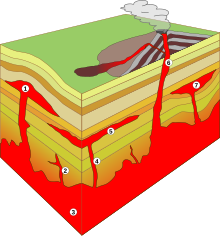Lopolith
In geology, a lopolith is a specific form of an igneous pluton . The solidified rock is formed into a central, bowl-shaped depression.
The intrusion is essentially concordant with the surrounding layers. The ascent paths of the igneous material are either chimney-shaped or designed as dykes .
Lopoliths can be found in rock units of all ages, from the Archean to the Eocene . They are often made up of large ultramafic and mafic layers. Gabbro is a common rock in lopoliths.
Examples are the Sudbury Igneous Complex in Ontario , the Bushveld Complex in South Africa , the Skaergaard Complex in Greenland and the Humboldt Lopolith in Nevada . The Sudbury and Bushveld occurrences were linked to large meteorite impacts and the associated melting of earth's crustal material.
The Duluth Gabbrokomplex who long considered the archetype of a Lopoliths had been necessary proved to be 16 km more powerful storage aisle .
The term was defined and first used by Frank Fitch Grout in the early 20th century when describing the Duluth complex in northern Minnesota and adjacent Ontario .
See also
Individual evidence
- ^ A b Richard W. Ojakangas, Charles L. Matsch: Minnesota's Geology . University of Minnesota Press, Minneapolis 1982, ISBN 0-8166-0953-5 , pp. 55–56 (English, limited preview in Google Book Search).
literature
- Rudolf Hohl (ed.): The history of the development of the earth . 6th edition. Werner Dausien Verlag, Hanau 1985, ISBN 3-7684-6526-8 , p. 200 f .
